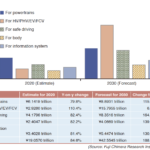ASIA ELECTRONICS INDUSTRYYOUR WINDOW TO SMART MANUFACTURING
Anritsu’s 5G Test Solution Preps up for Automotive Transformation
As the automobile industry undergoes a once-in-a-century transformation, the focus is now on the evolution on the four axes called connected, autonomous, shared & services, and electric (CASE).
In a connected system, conventional radio and digital television broadcasting, as well as infotainment, such as music and video, and information on traffic and safety are being distributed using cellular communication. Also, the V2X communication service, which exchanges information around vehicles by vehicle-to-vehicle and road-to-vehicle communication, is provided based on the dedicated short range communication (DSRC) technology.
In the future, the connected system will play an extremely important role in achieving autonomous driving (Fig. 1). In fact, it enables a vehicle to receive dynamic map information as a downlink signal, including dynamic information updated in seconds. In addition, as the information source of this dynamic map, the sensor information of each vehicle is shared as an uplink signal via communication.
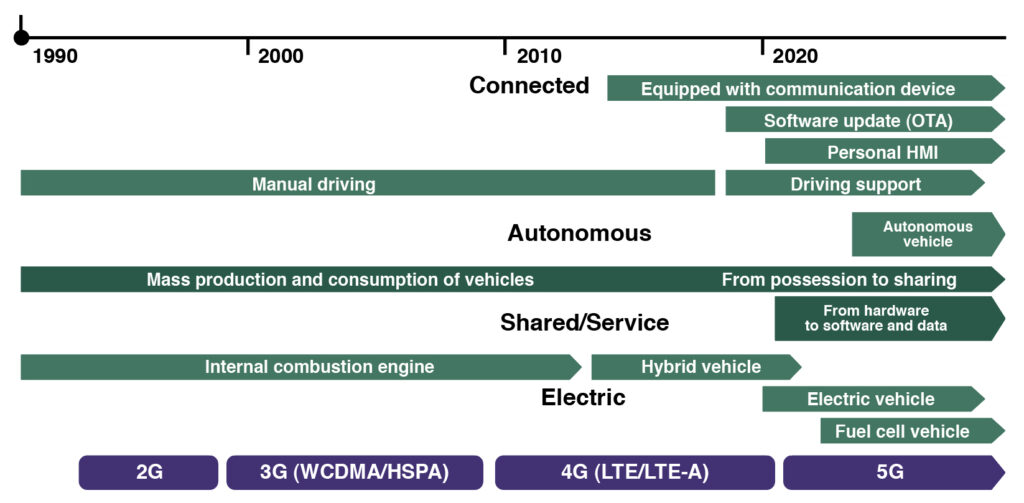
As automobiles evolve with CASE, they will change their characteristic from “being owned” to “being shared”. As a result, the business model in the automobile industry will undergo a major shift. With the creation of mobility as a service (MaaS), the automobile company will provide various services by adding value to transportation.
These will constitute the basic elements that form society and will realize smart cities. The realization of the MaaS business requires collection and analysis of various data including driving data and destination information possessed by vehicles. These data are handled by the cloud or by the edge server using digital transformation. The wireless communication environment connecting the vehicle and the network is an important factor.
Overlapping with Expansion Period of 5G
Various advanced automobile manufacturers have released vehicles compatible with Level 3 autonomous driving. Aiming for further sophistication in the future, each company will continue to work on the development of the autonomous driving technology. On the other hand, cellular networks are currently being expanded due to the promotion of 5G by telecommunications carriers in each country.
Based on such background, requirements for the connected technology in automobile manufacturers are being defined on the premise of using 5G.
5G has been standardized with the features of high speed and large capacity, ultra-low latency and high reliability, and multiple connections, and its network construction is rapidly progressing. These features will be used for advanced automotive applications, that is, will be utilized as an infrastructure for autonomous driving systems.
Ensuring Vehicle Safety through Authenticated Testing
Large-scale software and issues
The scale of software implemented in current automobiles has already become very large. Its amount exceeds those of IT application tools and smartphone operating system. The number of lines of the source code has reached 200 million (Figs. 2 and 3). When the functions become more sophisticated, being equipped with the automatic driving system, the scale of software will expand further. This will make it difficult to remove software bugs before releasing a vehicle. In such background, the function of improving software after vehicles are sold to customers should be implemented. Thus, software has to be updated to a new version via a cellular network. However, the fact that a vehicle is connected to a network as a connected car poses a severe security risk.
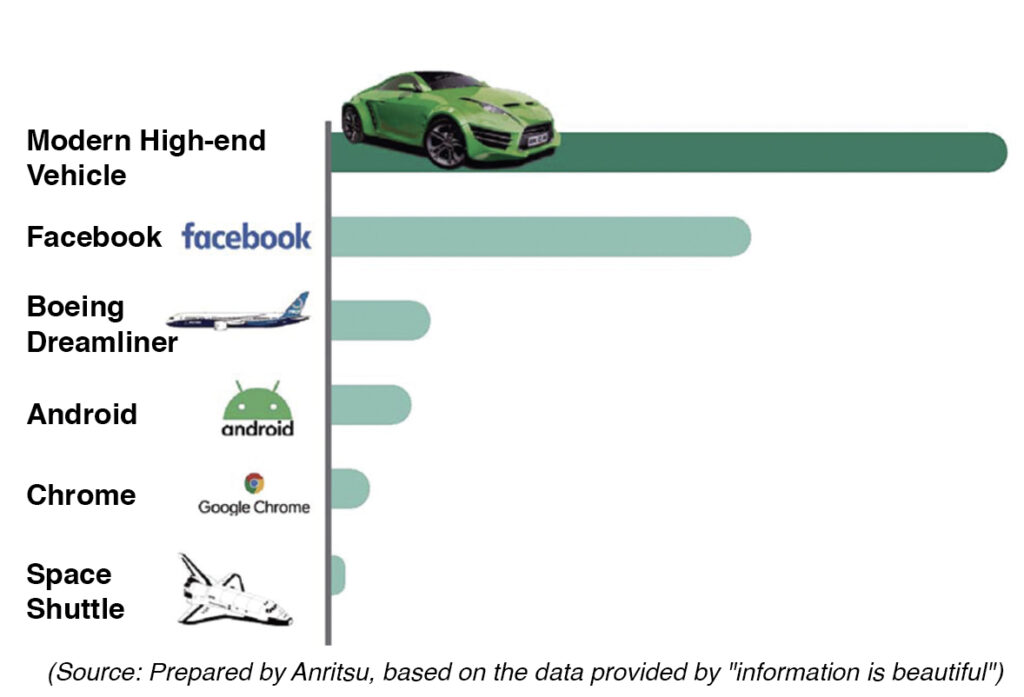
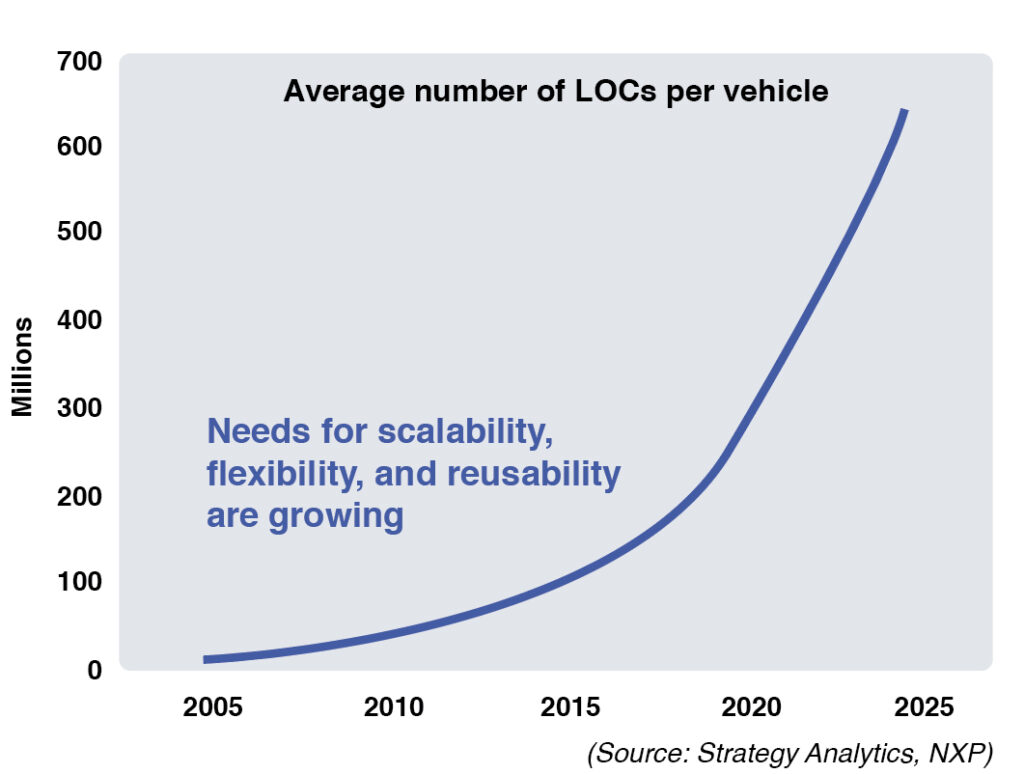
In fact, if a malicious cracker finds a security hole and breaks into a vehicle control system to take control of the vehicle, the damage becomes immeasurable.
Safety Measures for Large-Scale Software
Therefore, the communication will be deeply involved in the safety of automobiles. The World Forum for Harmonization of Vehicle Regulations (WP.29), a working group belonging to the United Nations and the United Nations Economic Commission for Europe (UNECE), has enacted rules on the cybersecurity and software updates of vehicles. In Japan as well, the type approval
system established by the Ministry of Land, Infrastructure, Transport and Tourism stipulates when to start application of the authentication test for each new model vehicle and continued production vehicle (Fig. 4).

Such efforts for regulations on authentication test will ensure the cyber security and enable software updates, realizing the safety of automobiles.
Certificate of SUMS Conformance through Authentication Tests
Type approval system
Certification in the cyber security management system (CSMS, Rule No. UN-R155) requires evaluations on two aspects, process and product.
On the process side, the certification authority (in case of Japan – the National Traffic Safety and Environment Laboratory, National Agency for Automobile and Land Transport Technology, Ministry of Land, Infrastructure, Transport and Tourism) examines and certifies the system and method of the cyber security of automobile manufacturers every three years.
On the product side, the proof that the vehicle is being developed and produced according to the certified process is required. By complying with these examinations, a CSMS conformity certificate can be obtained.
In addition, the software update management system (SUMS, Rule No. UN-R156) performs management of software updates for automobiles. The evaluations are also required on two aspects, process and product.
On the process side, the certification authority requires a software update system having sufficient security and a reception (Rx) software identification number (RXSWIN), which is an identifier for the software version control. On the product side, it is required to prove that vehicles are developed and produced according to the certified process. A SUMS certificate is issued by conforming to the examinations.
Providing a Pre-test Environment for Pre-evaluation
Contribution of Anritsu to authentication
It is important for automobile manufacturers to smoothly carry out legal authentications and obtain conformity certificates without delay.
For this reason, Anritsu Corporation provides a pre-test environment for pre-assessment by automakers or suppliers. This will provide customers with the opportunity to take the certification test smoothly and to learn how to deal with and solve problems when they occur.
As an example of a security test solution, security attack test signals such as fuzzing or port scan are generated on a personal computer and are input to the in-vehicle device at the IP level of 4G and 5G communication messages. Then, the behavior of the in-vehicle device and in-vehicle ECU can be examined (Fig. 5).
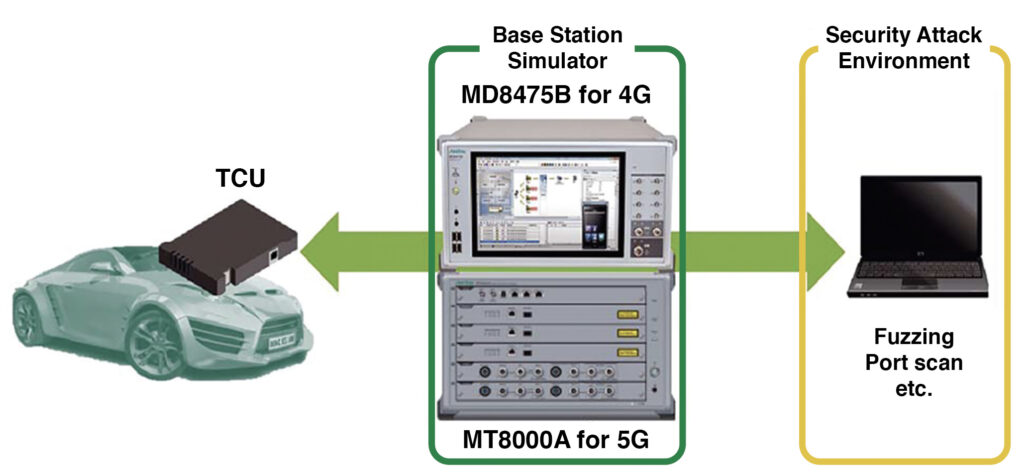
In addition, as a software update test, various over-the-air (OTA) connection environments that may actually occur are emulated, and it is verified whether the vehicle to be tested is correctly updated with new software. As the OTA connection environment, various radio wave conditions of cellular communication are emulated as shown in the figure (Fig. 6). The evaluation can be performed in many test cases.
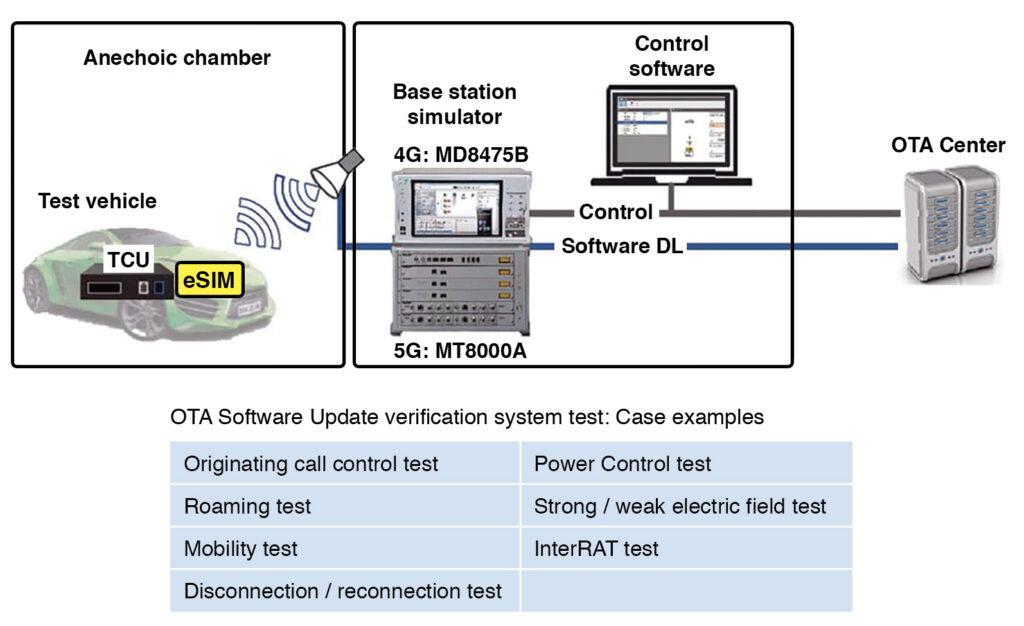
Evaluation of Antenna Characteristics of Higher-Order 5G Wireless Signals
Because various applications such as the above-mentioned dynamic map and sharing of vehicle peripheral information based on vehicle’s sensor information are used, communications using a large amount of data are required. As a result, automotive applications will adopt the multiple-input and multiple-output (MIMO) technology, in which different data are transmitted from multiple antennas for both downlink and uplink for the purpose of increasing speed. In addition to high-order MIMO cellular communications, antennas of many wireless devices, such as FM, AM, and Wi-Fi are also mounted at the same time, and therefore, the evaluation of effects of crosstalk between antennas is necessary.
To meet these requirements of the evaluation, the company started collaboration with Microwave Vision Group (MVG), which is developing OTA test systems, and established the environment for a full vehicle evaluation, where an entire vehicle under test is placed in an anechoic chamber for examination. These units have started to be delivered to automobile manufacturers such as Toyota Motor Corporation (Fig. 7).
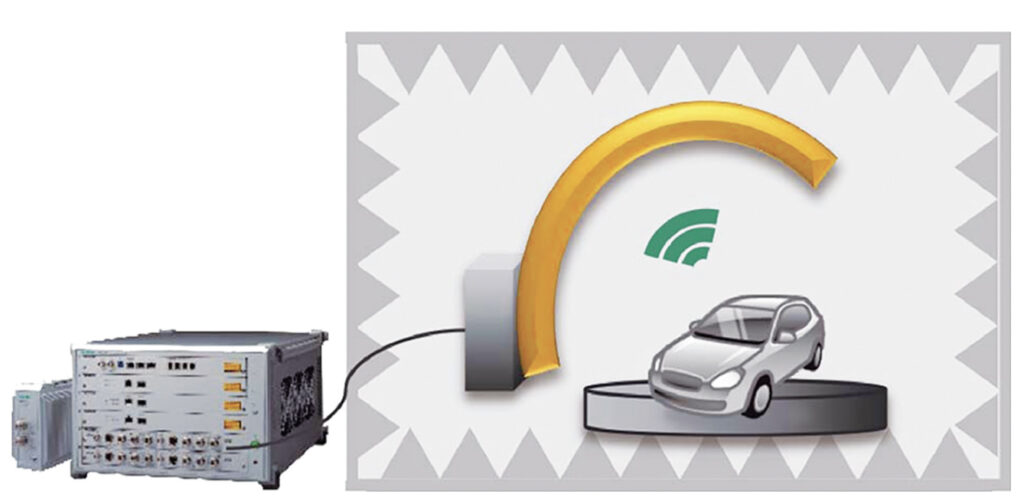
Anritsu’s Efforts for Advanced Vehicles
In 5G, in addition to antennas, the technology with functions higher order than in 4G is used for bundling of data carrier waves, called carrier aggregation (CA).
There is a strong need to quantitatively evaluate the high-speed and large-capacity communication performance of 5G, which constitutes an important feature of 5G. The number of combination tests is given by the product of the number of patterns of MIMO, the number of patterns of CA, and the numbers of patterns of all device parameters characterizing in-vehicle communications, such as communication band type, bandwidth type, etc. Such evaluation will incur large costs (Fig. 8).
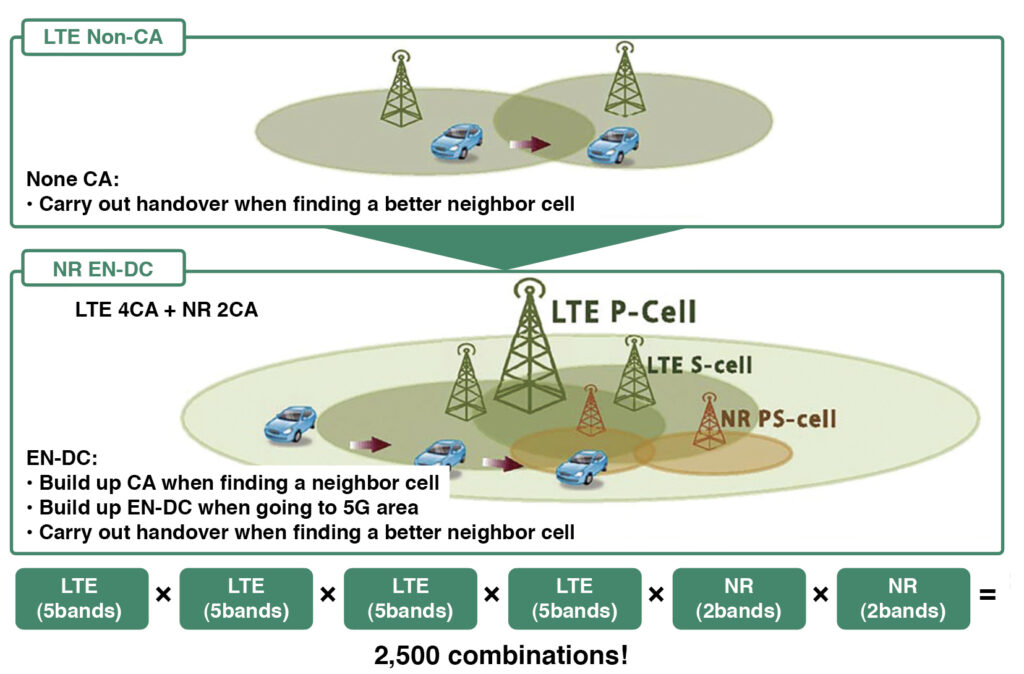
Therefore, Anritsu offers a turnkey tool called the SmartStudio Automotive Suite (SSAS). This tool automatically picks up the parameter information of the in-vehicle communication device, which is the device under test (DUT) to be evaluated, and automatically performs all test combinations. This will reduce the burden on the automotive evaluation engineer and contribute to dramatically reducing the evaluation cost.
About This Article:
Anritsu Corporation has provided contents of this article originally written in Japanese. AEI translated the article into English.



